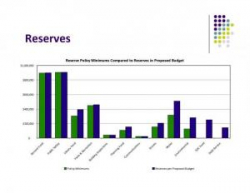Reserves Budgeted in Proposed Budgets
Reserves are essentially the amount of funds that are left over after all revenues and expenditures are projected for budget purposes.
There are essentially three different types of reserves for different reasons:
Contingency Reserves = these types of reserves are for unexpected or unforeseen items which may arise during the course of a budget period which were not specifically identified when the budget was adopted. These types of reserves still need to be specifically "appropriated", but require a supplemental budget to actually be drawn upon.
Unappropriated Ending Fund Balance Reserves = these types of reserves are to carry funds forward for some future project, to cover the following year's operating costs until November property taxes arrive, or to be utilized if a City emergency is declared.
Debt Covenant Reserves = these types of reserves vary by bond issue and depend upon specific covenants pledged when selling the bond issue in the market place. They typically come in the form of "at least one year's annual debt service".
Below are one-page summaries of each Fund's reserve levels used in balancing the City of West Linn's budgets. The City's Reserve Policy requires that Fund budgets are balanced while at least maintaining certain minimum reserve level calculated as a "percentage of operating costs".

